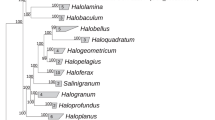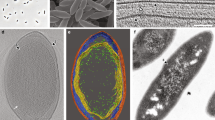Abstract
Three different species of the genus Sulfolobus1, S. acidocaldarius, S. solfataricus ( = Caldariella)2 and S. brierleyi3, have been distinguished4 by the conditions required for optimal growth, by the component patterns of their DNA-dependent RNA polymerases and by DNA sequence data. Many isolates of these species are able to grow chemolithoautotrophically using CO2 as the sole carbon source and the oxidation of S(0) with O2 yielding sulphuric acid, as the energy source, though a few others grow only heterotrophically. We show here that a strain of a novel Sulfolobus species, S. ambivalens, is alternatively able to live by an anaerobic mode of chemolithoautotrophy, also using CO2 as the sole carbon source, but using reduction of S(0) with H2, yielding H2S as the energy source. This mode of growth is correlated with the amplification of a plasmid, pSL10.
This is a preview of subscription content, access via your institution
Access options
Subscribe to this journal
Receive 51 print issues and online access
$199.00 per year
only $3.90 per issue
Buy this article
- Purchase on Springer Link
- Instant access to full article PDF
Prices may be subject to local taxes which are calculated during checkout
Similar content being viewed by others
References
Brock, T. D., Brock, K. M., Belley, R. T. & Weiss, R. L. Arch. Mikrobiol. 84, 54–68 (1972).
De Rosa, M., Gambacorta, A. & Bu'Lock, J. D. J. gen. Microbiol. 86, 156–164 (1975).
Brierley, C. L. & Brierley, J. A. Can. J. Microbiol. 19, 183–188 (1973).
Zillig, W., Steuer, K. O., Wunderl, S., Schulz, W., Priess, H. & Scholz, I. Arch. Mikrobiol. 125, 259–269 (1980).
Allen, M. B. Arch. Mikrobiol. 32, 270–277 (1959).
Segerer, A., Steuer, K. O. & Klink, F. Nature 313, 787–789 (1985).
Zillig, W., Stetter, K. O. & Janekovic, D. Eur. J. Biochem. 96, 597 (1979).
Ouchterlony, Ö. in Progress in Allergy VI (eds Kallos, P. & Waksman, B. H. 30–154 (Karger, Basel, 1962).
Fischer, F., Zillig, W., Steuer, K. O. & Schreiber, G. Nature 301, 511–513 (1983).
Zillig, W., Schnabel, R. & Stetter, K. O. Curr. Topics Microbiol. Immun. (in the press).
Birnboim, H. C. & Doly, J. Nucleic Acids Res. 7, 1513 (1979).
Author information
Authors and Affiliations
Rights and permissions
About this article
Cite this article
Zillig, W., Yeats, S., Holz, I. et al. Plasmid-related anaerobic autotrophy of the novel archaebacterium Sulfolobus ambivalens. Nature 313, 789–791 (1985). https://doi.org/10.1038/313789a0
Received:
Accepted:
Issue Date:
DOI: https://doi.org/10.1038/313789a0
This article is cited by
-
What is an autotroph?
Archives of Microbiology (2012)
-
Life in hot springs and hydrothermal vents
Origins of life and evolution of the biosphere (1993)
Comments
By submitting a comment you agree to abide by our Terms and Community Guidelines. If you find something abusive or that does not comply with our terms or guidelines please flag it as inappropriate.



